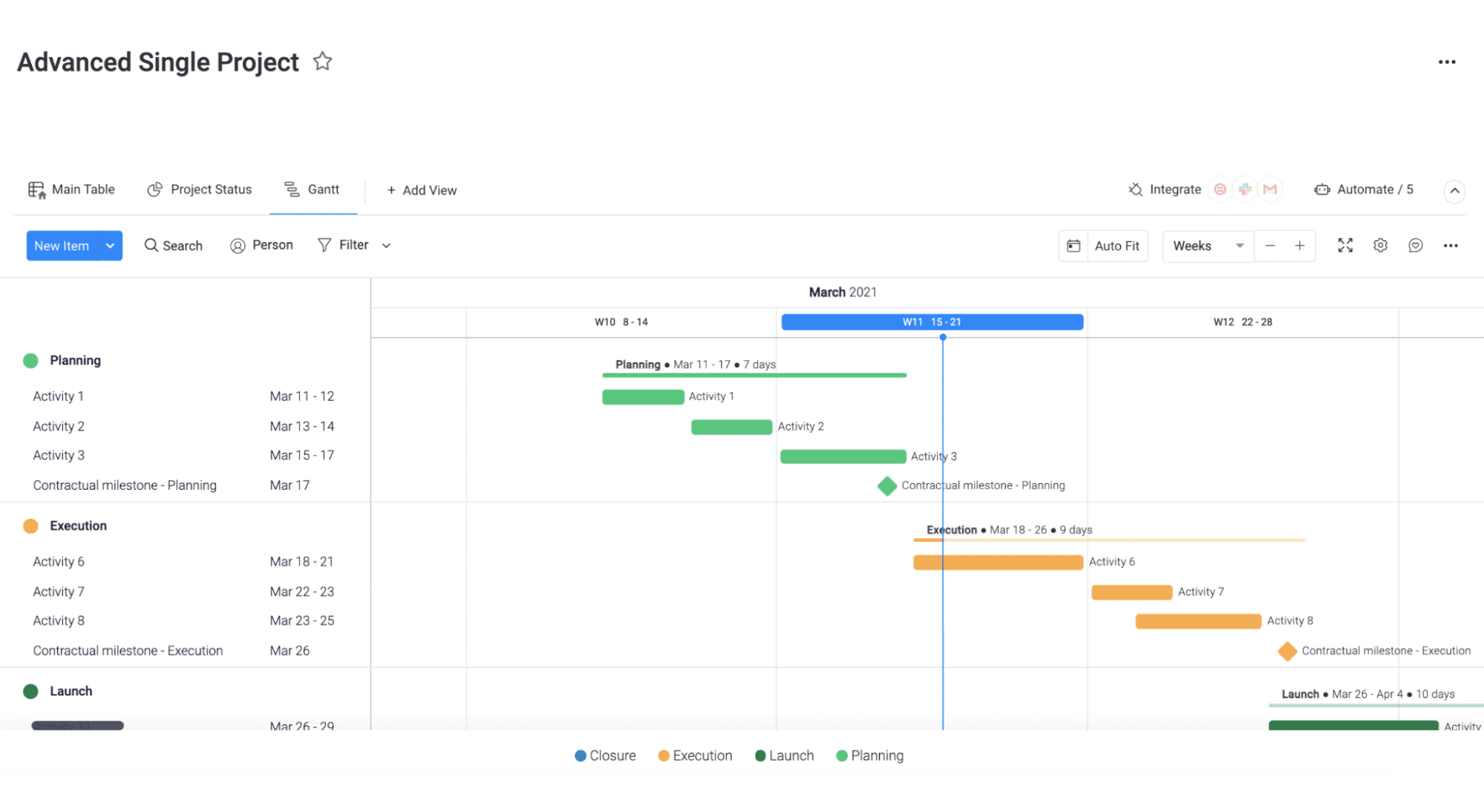When it comes to balancing acts, project managers are right up there with trapeze artists.
A project manager works with many teams and factors to balance their workloads, specific skills, and budgets in order to successfully deliver a project. This often crosses over into the territory of something called resource management.
In this article, we’ll take a closer look at the ins and outs of resource management and what it takes to optimize the process across teams.

What is a resource in project management?
In project management, a resource is anything needed to get a task or project done. This could refer to a person, a tool like an app or piece of software, or even a facility.
Resources are generally categorised into two categories—tangible and intangible:
Tangible resources are also commonly referred to as tangible assets or physical assets. Some examples include hard currency, real estate, labour, or equipment.
Intangible resources are more abstract and could be something like an idea, a defined skill set, or a technology patent.
Additionally, it’s worth addressing the three types of resources that tend to occupy most of the project managers or resource managers’ time:
- Human resources: Otherwise known as people, they’re the ones you need to carry out tasks. This could involve a wide range of management activities, whether it’s job recruitment and time management or measuring employee performance against KPIs.
- Materials: When tangible resources or materials required for completing a project are distributed across more than one team, things can get a little messy. It’s a good idea to have a living document or platform to keep track of it all.
- Relationships: This includes relationships between internal teams, as well as communication with external stakeholders like vendors, contractors, clients, and subcontractors.

What is the difference between resource allocation and resource management?
Resource management is the process of planning, scheduling, and allocating resources throughout the project management cycle. Resource allocation, on the other hand, is specifically recognising the best available resources for a project and assigning them to team members.
Let’s take a look at planning a tech meetup for example. There will likely be a few teams involved: Accounting, communications, operations, and maybe even developers to provide insight on the presentation content or to leverage their networks for guest speakers or invitees.
In this scenario, resource management could involve managing the budget for each expense, the venue itself, and PR efforts. Resource allocation would be assigning each team to specific functions or granting them a portion of the total budget.
What are the different types of resource management?
There are three primary types of resource management: Resource allocation, resource forecasting, and resource levelling:
- Resource allocation is assessing the available resources, performing analysis around how they can be used, and then distributing them accordingly to teams.
- Resource forecasting is all about trying to predict future resource requirements for your teams to reduce waste and deliver projects more efficiently and cost-effectively.
- Resource levelling is a way for managers to uncover which resources might be underused or used inefficiently. This could help them deploy the resources in a different way and in turn optimise efficiency.

Who drives effective resource allocation and management in a business?
Depending on the size and budget of an organisation, resource allocation and management might be handled by different individuals, whether it’s by department, by a general project manager, a team lead, or a delegated resource manager.
A resource manager is very similar to a project manager but the roles are in fact, very distinct. A project manager is responsible for creating and assigning tasks, while a resource manager focuses on allocating the resources required to complete those tasks.
This role is especially important when working across teams. In a survey of 500 managers in global companies, 81% of them said their team members work on multiple projects in parallel.
Although it can seem like a pesky additional task, dedicated resource management is a worthwhile use of time that should be handled by someone who has visibility above the varied priorities and activities of different teams. In fact, 80% of “high-performing” projects are led by a certified project manager.
Top benefits of cross-team resource management
Avoid unforeseen bumps in the road
Resource management requires a clear understanding of available resources and how they can be used. With this preparation, it’s much easier to predict or account for potential problems before they happen.
Additionally, if things do go awry, you will still be able to refer back to your resource management plan—this is particularly helpful when you need to demonstrate to stakeholders that despite best practices, you did everything you could with the resources available to you.
Help prevent team burnout
Resource management plays a grander role in workload across teams, too. In 2020, 71% percent of workers reported that they experienced burn out. Burnout and stress can result in lower levels of productivity, potentially causing reduced quality or late delivery of a project.
Effective resource management ensures that all teams and members have what they need to get their work done, and prevents team members from having a workload that is out of reach.
Foster efficiency over time
Tracking and managing resources over time not only helps your current projects achieve success throughout implementation but also the ones down the line.
When you keep tabs on this information, whether in spreadsheets or in project management software, you create a sort of data library that you can refer back to when you plan your next project.
We’ll touch more on this soon.
4 tips for resource management across teams
As we touched on earlier, resource management is already a pretty multifaceted task—or set of tasks, really. Add different teams to the mix, and well, you’ll be glad you took a page from our book and tried these tips to either build or improve your resource management strategy.
1. Invest in technology—and stick with it
To be the most effective, resource managers and project team members alike need tools that are meant to facilitate communication, bring all the work into one place, and of course, automate the more mundane tasks.
The beauty of today’s available software is the capacity to integrate with your most loved tools.
For example, you can use Zapier to automatically connect monday.com’s powerful Work OS with info from RingCentral’s powerful business communications platform, with no coding experience required. This is extremely useful, especially if you’re managing resources with distributed, remote, or hybrid teams as well.
By housing your communications and data in one digital space, you create a reliable, up-to-date source of truth for everyone involved in a project, regardless of team or resources allocated.
2. Embrace different ways of working across your organization
While it is important to implement standard practices across teams, even resource management benefits from celebrating the ways different teams tend to work. This goes hand in hand with the technology you choose.
We recommend you choose tools that allow different teams to build workflows the way that works for them, while giving them visibility through timeline views or dashboards. This allows resource managers to communicate and track changes as they go, while keeping teams informed in a way that is digestible for them.

3. Create a contingency plan
Resource management is not all roses,but you can prepare with a contingency plan in the event that you run into some weeds.
Resource shortages can happen, regardless of how many teams you’re working with. That’s why it’s important to create a sort of reactive backup plan that identifies potential situations for shortages and includes responses. This will minimise risk and decrease panic if a problem ever arises.
4. Use capacity planning reports
Managing people resources requires resource managers to assess the skills, qualifications, experience, and availability of team members in order to ensure project teams are well equipped.
A capacity planning report qualifies a project’s billability while providing accurate effort estimates for the future. It also sheds light on which activities are occupying your teams’ bandwidth.
There are plenty of different vantage points out there for such reports, so it’s worth reading up on. Some of the best software uses AI to estimate future capacity based on current demand patterns.
Why should an organization invest in tools for resource management?
Resource management tools are designed to streamline all resource management efforts, from planning and allocation to management and tracking and more.
High-performing project teams know that using the right software can really make a difference. In fact, 77% of high-performing projects involved the use of project management software.
There are a lot of options out there that can help you achieve resource management success—we’ve flagged some of the most important reasons to take the plunge.
Real-time, in-context communication
Engaging your teams during a project’s execution is paramount. After all, there will be points in the project where things get stuck or require real problem-solving. Frequent and in-context communication can help teams stay connected and work through challenges at a much faster pace.
Resource management software like monday.com houses all of your tasks in one centralised place, where teams can communicate with each other directly on an item. When they need to refer back to previous conversations or feedback, they can easily filter and find this in one place instead of scattered threads on different platforms.
It’s also easy to send out updates by notifying individuals or entire teams. The best part is that all of this can be accessed from a mobile app or desktop.

Data-driven decision-making
Resource managers need to make swift, informed decisions at every step of the project cycle. The best way to do this is with accurate data that is easy to access and understand. Resource management tools allow you to import data and turn it into dashboards, reports, and more.
They also tend to have features for progress tracking in addition to classic functions like formulas and pivot tables. Smart filters make it easy to find exactly what information you want, in order to make data-driven decisions to avoid overspend or unbalanced resource allocation.
Transparency and accountability
33% of employees said they experience a lack of open communication that has a negative impact on their morale and proactivity. It can also make them feel like their colleagues don’t understand or value their work as they should.
To avoid the pitfalls of siloed teams, resource management tools can be used as a vehicle of transparency and accountability across teams. They allow teams to showcase their tasks, assign owners, update statuses, and highlight dependencies to show the bigger picture of how these items contribute to a larger goal.
Efficiency for all
Resource management at its best is the perfect storm of resource allocation and proactive thinking, in order to deliver a project successfully and keep teams engaged and satisfied.
The best way to support this fusion for many teams is to use a resource management tool to house all important information and accurately report and communicate in real-time, while accommodating the variety of work styles and needs of team members.
Originally published Jul 19, 2021, updated Jan 16, 2023
